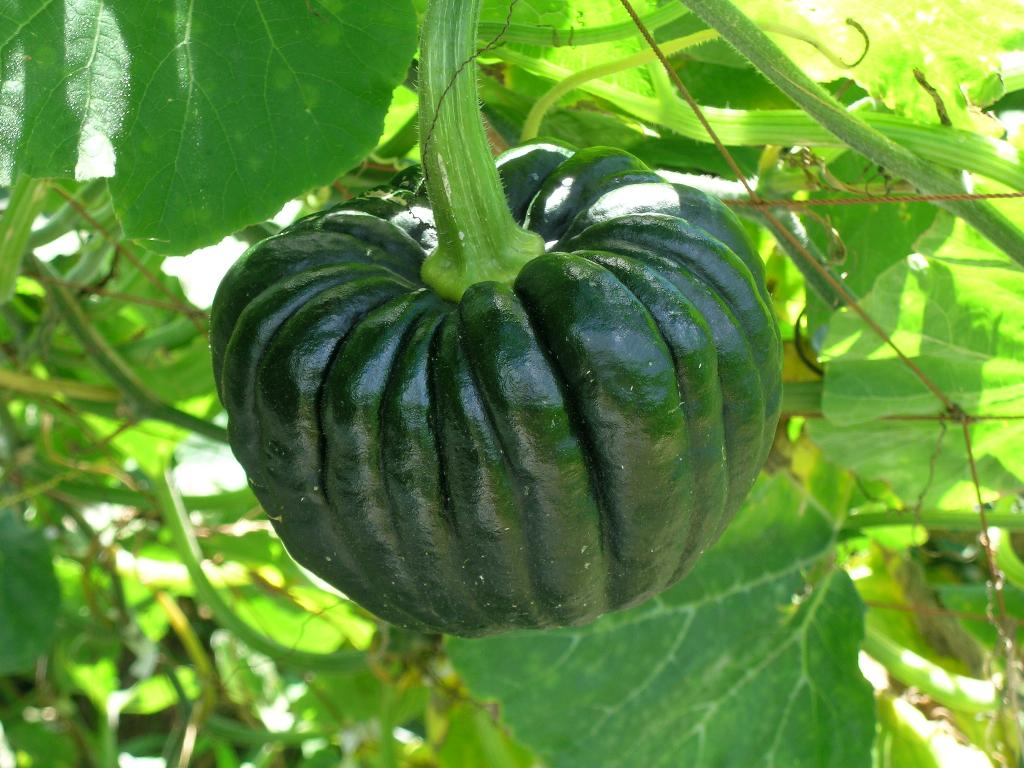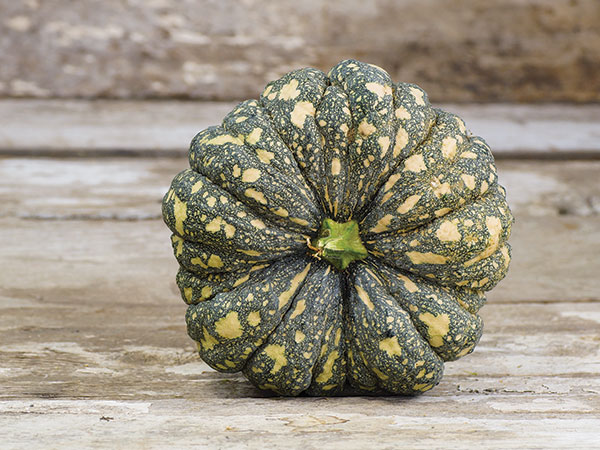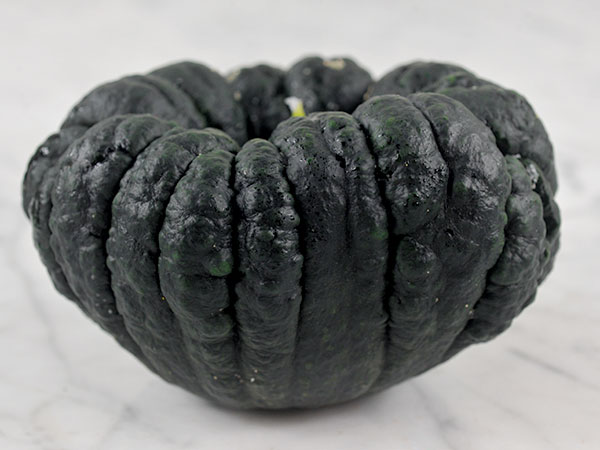|
|
Chirimen is a traditional kabocha squash, dento yasai, of Japan. This tasty variety of Japanese pumpkin forms a flat globe with distinct ribs and warts (resembles cauliflower) that can reach 8" in diameter. The dark green skin matures to a buff color. Creamy yellow, moist thick flesh has a sweet and nutty flavor.
This ancient variety was very popular during the Edo period (1603-1867). It was introduced to the USA for the first time in 1922 by seed producer Aggeler and Musser of Los Angeles. It was introduced in the collection of the Vavilov Institute in Russia in 1927. "Chirimen" means "crepe" in Japanese.
Beautiful dull bronze-orange skin. Have deep-orange, moist, sweet flesh. Needs a long growing season to mature. In a normal season this can be done at Heritage Farm, which is on the Iowa-Minnesota border.
Culinary tips: Use in tempura, stir-fry or bake. The Japanese prepare it by simmering peeled chunks in chicken broth or dashi and flavoring with sugar, soy sauce and mirin.
|

Very suitable for cooking.
‘Black Futsu’, another Japanese variety with sweet, nutty flesh. It is sometimes called "Kurokawa Futsu". The fruits are heavily ribbed and dark, black-green when picked, quickly developing a heavy grey bloom, beneath which they ripen to a tawny orange.
The golden orange flesh is delicious with a strong taste similar to hazelnuts. Fruits are large with weights close to 10 pounds.
thelostseed.com.au futsu
digdelve fustu
Seed reviews:
Ireland: grows well
Malaysia;Grows well
Grown in Washington, Indiana, California
Varieties:
Kogigu
Fruits start out green, upon maturity mellowing to medium brown. The fruits weigh a very practical 1-2 lbs. The dark orange flesh is sweet and fruity tasting, with a nutty flavor, and fine grained. Quality is very high. Keeping quality is excellent.
Hidemi
Small, uniform fruit. This selection from Japan is smaller and more uniform than Black Futsu. Hidemi bears beautiful fruit, ripening from dark green to brown. Its plants are short vining and should be planted closely. Ideal household size of 1-1.5 kg (2-4.5 lbs). Hidemi`s pulp tastes nut-like, and children love it uncooked. Hidemi is an so far unknown variety which was sent to us by a Japanese woman. We named this sort after her. 100 days.
Bungkan
Also known as Beung Karn. Excellent for meals and highly decorative. Bungkan F1 bears flat, round, slightly ribbed fruits. These stay small with about 1 kg (2,2 lbs) in weight. Their dark green color changes to a pretty nice ochre while ripening. This productive Asian variety yields early. Its dark yellow flesh is a tasty ingredient for soups and other dishes.
This variety produces small sized fruits which have dark green and rough-textured skin. Yellow-orange flesh is very sweet and delicious, excellent for cooking and soups. The plant grows very vigorously in subtropical warm climates and is very prolific. This variety is very popular in Thailand and Southeastern Asia.
|
|
Gem squash, also known as Rondini or Rolet Squash is a well known South African favourite. The gem squash has a creamy, pale orange flesh with a lovely texture. Of all the squashes this is probably the easiest and most reliable one there is. A reliable and heavy cropper, each plant can produce fifteen or more fruits grown on trailing vines.
Loves to climb.
Varieties:
Smarag
In many gem-squash producing areas, Smarag is being used as a direct replacement for Rolet with trial and field plantings indicating the possibility of a 30 % increase in yield. Vines are extremely vigorous and fruit size is better than that of Rolet. Production in winter in sub-tropical areas is very successful. The fruit retain the dark green colour longer than Rolet and the flavour is considered superior. The fruit is a globe shape and very dark green in colour. Smarag is widely adapted and is generally used as mature gem squash, but can also be used as baby and young gems.
|
|
Very suitable for cooking. Hybrid Acorn.
This innovative acorn squash was bred by Dr. Brent Loy at the University of New Hampshire.
This bushy, compact plant will reach 2-3 ft/60-90 cm tall and spread 4-5 ft/120-150 cm without vines. The plant produces 3-5 fruit per bush.
85 days to maturity.
sed reviews
very productive. very compact, no vines.
|
|
Rare Australian Heirloom pumpkin. The flesh is a rich orange colour, dry and sweet. The skin is dark green and hard, making this an exceptional keeper. Plant type: Tender annual Sow when: Spring – min. soil temp 15˚c Sow where: Punnets or direct
Spacing: 150cm Position: Full sun Harvest: 130 days
|

Kogiku (small chrysanthemum) Pumpkin
This is a small pumpkin with a diameter of 15cm. It is so named because it looks like a chrysanthemum flower when viewed from above. The brand is Kanda-kogiku, which contains much Vitamin C and carotene in its bright yellow flesh, and features its mild and refreshing sweetness. The cultivation started in the mid-1960s in the former Nakajima Town (present-day Nanao City) when rice fields were converted. For draining the fields and producing bright-colored pumpkins, a vertical cultivation method in greenhouses was developed. Its mild flavor suits subtle seasoning, and it is in high demand by traditional Japanese restaurants. It is shipped to the Kansai district in addition to within Ishikawa. It is one of the Noto traditional vegetables approved by the Noto Vegetable Promotion Association. It is harvested from late June through mid-August.
An early maturing and disease resistant high producer, this large Japanese pumpkin has uniform 2 lb. fruits. Dark, textured, shiny green skin with 17 to 20 slits, covers flavorful and sweet, dark yellow flesh. Popular with Japanese caterers, professional chefs, and the gourmet food industry.
|
|
Varied colours, can be dark green striped with white, ripening to orange, brown colour. Named after its shape (pawpaw or papaya). Grown in Australia.
Varieties:
Black Paw Paw. Completely black skin.
Caipira
South American breed, difficult to find in central Europe. Caipira is the Brazilian name for a big "caipirinha". Plant: vine; Fruit: papaya-shaped, Size: 12 x 20 cm; Size: 12 x 20 cm; Usage-Recommendation: Frying/Grill, Oven, Steam, Salad/Dip, Deep-Fry
Storage time: ++++ Weight: 0.3 kg Maturity: 120 days
Goiana
Oblong fruit. Taste : Sweet. Named after Goiana, a city in Brazil. Also called Mini Paulista.
|
|
|
|

Shishigatani or Toonas Makino Pumpkin
This unique Japanese pumpkin was developed in the Bunka era of the Edo period (1804-1818). It is one of the kyo yasai, or traditional vegetables in the Kyoto region. This kabocha squash is used in shojin ryori, a type of vegetarian cooking prepared by Buddhist priests. The black fruit skin is distinctly ribbed and warted and ripe when the skin turns light brown. The fine-grained flesh is a delicate light yellow color and has a delicious, nutty flavor.
Highly nutritious, and recommended to keep people from getting paralysis when eaten in the hottest part of summer.
Culinary tips: Simmer in dashi or chicken broth with sugar and soy sauce. Add mirin towards the end of cooking. Prepared in soups, stews, baked, grilled and tempura.
Seed Reviews:
Washington- Needs longer growing season. Fruits died before harvest.
RI - Not good to grow in a container, large vines.
CA - Grown successfully with decent yield in a container.
Germany - Season too short to reach maturity, started fruiting in late July.
Oregon - Grows well for the climate.
Colorado - Grows well, needs longer season.
Grown successfully in Arizona.
|

Tetsukabuto squash is a hybrid between Cucurbita maxima (which originated in South America from the wild C. maxima ssp. andreana over 4000 years ago) and Cucurbita moschata, whose cultivars (which include butternut and crookneck squash and pumpkins) are generally more tolerant of hot, humid weather and insects. Tetsukabutos were developed in Japan and introduced to Brazil in 1960. They are popular in the cuisine of both countries. Commonly called a Japanese pumpkin.
At harvest time the squash is solid green except for an orange patch where it rests on the ground. While in storage Tetsukabutos gradually turn orange. Most of the color change happens in the first six months.
Varieties:
Iron Cap
F1 hybrid. 2 - 4 kg fruits. Iron Cap has to be planted together with a pollinator as it is male sterile Recommend to plant one “Butternut” for 10 Iron Cup for pollination.
Armor F1
Interesting inter-species hybrid. Armor F1 is a productive crossing resulting a mix of C. maxima and C. moschata. Its dark green, uniform fruits weigh 1.5-1.8 kg (2,2 lbs). They can be stored long-term. This Hybrid is self-sterile. It can be pollinated with C. maxima or C. moschata. Days to maturity: 100-110. Normal to vigor vining. Can be stored up to 8 months and prepared to an excellent dish.
|

Green 8-lb fruits have tan spots on the rind. Flesh is yellow-orange, sweet and flavorful with a smooth texture; a great eating variety that performs very well in our Missouri summers, and stands up well to pests and disease. Attractive for decoration and superb for the table; a rock-hard rind makes this a great keeper. A Thai market variety that is sure to become popular here. Also called Frog pumpkin.
Seed Reviews:
Austria: Grows well. May need longer season, producing late. No white spots on fruit.
PA: Grows well, produced late, tastes great.
MN: Grows well. Mature fruit had white spots.
MO:Grows well. Stands up to squash bugs. Late producer, large vines.
HI: Grows well. Delicious fruit.
Turns tan in long term storage.
Varieties:
Thai Kang Kob
A lovely sea green-colored squash that turns chestnut color in storage; pumpkin- shaped, very ribbed and warted. Weighs about 6-8 lbs; vines produce well and had good resistance to squash bugs and other pests. The orange flesh is richly flavored, sweet and fragrant; great for curries, soups, stir-fries and more. Andrew Kaiser brought back this great variety from Thailand in 2006. 110 days.
Fagtong Sri Muang
F1 hybrid. This Asian variety bears beautiful dark fruit with a weight of about 2-3 kg (4,5-6,5 lbs). Cucurbita moschata need a lot of warmth and should be precultivated. That way, varieties with a maturing period of up to 110 days grow even in colder regions just as Central Europe.
Sowing method: space is to be left in view of its trailing.
Black Mekong Warty Pumpkin
Specialty South East Asian variety producing medium sized flat shaped fruit with blackish green warted skin. Named after Mekong River between Vietnam and Thailand. Bright orange/yellow flesh that sweetens as fruit matures, very tasty. Prefers warm growing conditions where it is vigorous. Harvest 90 days.
Seed Review:
Review:
Have planted this strain (10 seeds) this year and have (so far) the following experiences:
This strain is resistant to mildew and also the snails - which could be everywhere this year do nothing. But the plants are extremely late developers. I first thought that would come, but then suddenly in August, there was a veritable explosion of foliage and tendrils that could not be stopped by any boundaries and fences. In record speed, the plants have grown over into neighboring garden.
Unfortunately, the harvest looks meager this season due to the bad weather: a ripe fruit and three previously unripe ones. Therefore, you should definitely choose a fully occupied place in the garden and use a black foil.
This strain is not suitable for beginners.
Baramasi
Baramasi is a very popular home garden variety in India and appears to come in 2 forms- round, flattened and ribbed and a taller, rounder version with the same markings. The colour of the rind turns more tan as the fruit matures in storage. The long, low vines produce fruit ranging from 2.5kg to 3.5kg in around 95 days, but the taller version is a little lighter in weight. Inside, the mid-yellow coloured flesh is thick, of medium firmness, moist and sweet with good flavour. This variety has been bred for good disease resistance.
|
|
Turban squash. Good for cooking and pies.
These pumpkins were once the pumpkin emblem of Victoria, Australia.
|

THE AMAZING YOKOHAMA SQUASH
BY RANDEL AGRELLA
Until the mid-19th century, Japan was seen as a mysterious Oriental land, closed to most westerners and virtually all Americans. In the 1850’s, with Commodore Perry’s forcible “Opening of Japan” the situation changed dramatically. Japanese trade goods and art became available, captivating the imagination of a generation of Americans.
Plants were part of the cultural avalanche. One such is Yokohama squash, a superior winter squash that had evolved through centuries of painstaking selection by meticulous Japanese gardeners.
In America, Yokohama was introduced by a wealthy New York City horticulturist, James Hogg. Hogg’s brother Thomas visited Yokohama, Japan on business, sending home seeds from Japanese varieties hitherto unknown in the West. In 1863 Hogg successfully grew the variety, naming it “Yokohama.” Hogg claimed it was superior to the Hubbard types which were at the time the standard in American gardens.
Other horticulturists enthusiastically agreed, and Yokohama squash soon experienced a short-lived burst of popularity. J.H. Gregory, as quoted in The Garden, an Illustrated Weekly Journal, London, 1873 wrote: “It is quite flat in shape, with somewhat of a depression on each end...It is deeply ribbed, and the flesh, which is of a lemon colour, is remarkably thick, making it the heaviest of all Squashes in proportion to its size. The flesh is very fine grained, smooth to the taste, and has a flavor resembling the [Canada] Crookneck...In external color, before ripening, it is of an intensely dark green, covered with blisters like a toad’s back; as it ripens it begins to turn a light brown at both the stem and blossom ends, and, after storing, it soon becomes entirely of a copper-like colour, and is covered with a slight bloom.”
Sadly, Yokohama fell out of favor after a couple of decades, virtually disappearing until being rediscovered in the early days of the heirloom movement. Modern gardeners were no less impressed. William Woys Weaver wrote in Mother Earth News that when he grew Yokohama it “resembled large chunks of hardened lava. Gray-black, other-worldly, yet hauntingly beautiful, this unique heirloom vegetable...was a visual study in the Japanese affection for serenity through form and texture.
“Not only that, the ‘Yokohama’ possesses one of the most complex flavors I have run across in any squash or pumpkin I have grown. Everyone’s taste buds are different, but I detect hints of Asian pear, mango, avocado, lemon balsam, and if you have experience with tropical fruits, the unmistakable aroma of sapote. Can this be a squash?”
Yes, it can be a squash, but of the most admirable kind. Not only is the variety possessed of singular flavor and texture, but the 3- to 4-pound fruits can be stored for many months with no loss in flavor. Disease- and pest-resistance come as a bonus, making Yokohama a world-class heirloom, deserving of a place in every garden.
yokohama seed
Listed by both Burr (1863) and Vilmorin (1885).
Seed Reviews
Grown successfully in USA with good result and great taste, with some special cases:
Idaho: bland, watery.
Vancouver, Canada: 5 stars taste and grow. Zone 8.
Vermont:Didn't taste good.
Oregon:No fruit
|

Excellent affinity for cucumber, melon, watermelon. Promises high production.
Strongly resistant to Fusarium. Plant is vigorous, tolerant to both heat and cold. The roots grow well when cold. This variety shows regular growth and good quality fruit setting under intensive cultivation.
The interspecific hybrid developed from a cross between C. maxima cv. Rimu and C. moschata cv. Rifu, “Shintosa,” is a popular rootstock for different cucurbits, especially preferred in watermelon grafting for its Fusarium wilt resistance, cold tolerance, and the ability to increase fruit weight, fruit quality, and plant vigor (Davis et al., 2008). C. maxima, in general, has better fruit flavor and texture than C. moschata but is not as resistant as C. moschata to diseases and abiotic stresses. Interest in interspecific crossing between C. maxima and C. moschata has centered on transferring high-quality flesh traits from C. maxima to C. moschata and on introducing resistance traits from C. moschata (Whitaker and Robinson, 1986).
Interspecific hybrid rootstock compatible with cucumber, watermelon and oriental melon. When growing for edible usage of self-fruits, need to plant pollinator variety together. Adapted to wide range of climatic conditions. Tolerance to Fusarium disease and nematode.
Variety SHINTOSA TETSUKABUTO
Species and Growth habit C, maxima X C. moschata Vine
Maturity (Days from sowing) 110~130
Fruit Color Dark Green
Flesh Color Yellow
Fruit:
Length 12~14 (cm)
Diameter 15~17(cm)
Weight 1500~2000 (gram)
The grafted plants upon rootstock Shintosa perform very well under high and low temperature conditions. It is resistant to Fusarium wilt.
If the plants grow too vigorous, the fruit will be deformed and have hollow inside. In that case, you should reduce the fertilizer, nitrogen in particular.
Shintosa has been widely used as rootstock at home and abroad for many years and we enjoy a fine reputation for its quality.
|
|
|
 MBZ
MBZ
